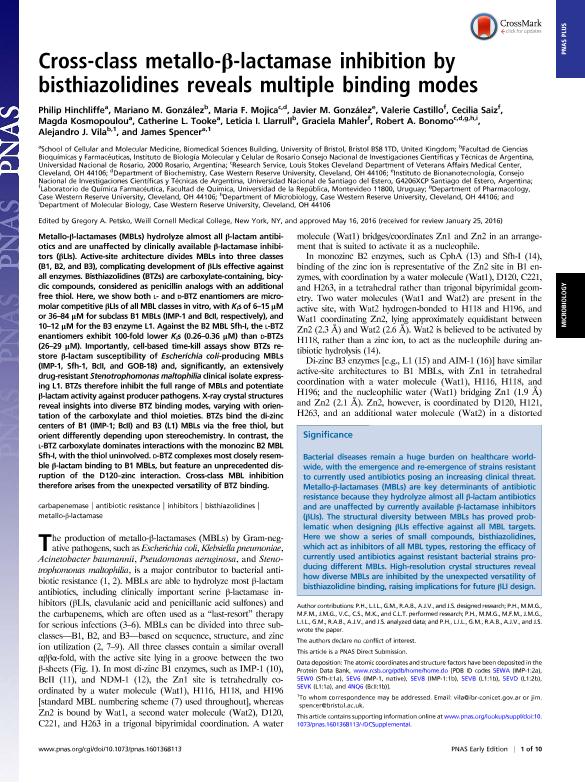Artículo
Cross-class metallo-β-lactamase inhibition by bisthiazolidines reveals multiple binding modes
Hinchliffe, Philip; Gonzalez, Javier Marcelo ; Mojica, María; Gonzalez, Javier Marcelo
; Mojica, María; Gonzalez, Javier Marcelo ; Castillo, Valerie; Saiz Garcia, Cecilia; Kosmopoulou, Magda; Tooke, Catherine; Llarrull, Leticia Irene
; Castillo, Valerie; Saiz Garcia, Cecilia; Kosmopoulou, Magda; Tooke, Catherine; Llarrull, Leticia Irene ; Mahler, Graciela; Bonomo, Robert; Vila, Alejandro Jose
; Mahler, Graciela; Bonomo, Robert; Vila, Alejandro Jose ; Spencer, James
; Spencer, James
 ; Mojica, María; Gonzalez, Javier Marcelo
; Mojica, María; Gonzalez, Javier Marcelo ; Castillo, Valerie; Saiz Garcia, Cecilia; Kosmopoulou, Magda; Tooke, Catherine; Llarrull, Leticia Irene
; Castillo, Valerie; Saiz Garcia, Cecilia; Kosmopoulou, Magda; Tooke, Catherine; Llarrull, Leticia Irene ; Mahler, Graciela; Bonomo, Robert; Vila, Alejandro Jose
; Mahler, Graciela; Bonomo, Robert; Vila, Alejandro Jose ; Spencer, James
; Spencer, James
Fecha de publicación:
06/2016
Editorial:
National Academy of Sciences
Revista:
Proceedings of the National Academy of Sciences of The United States of America
ISSN:
0027-8424
Idioma:
Inglés
Tipo de recurso:
Artículo publicado
Clasificación temática:
Resumen
Metallo-β-lactamases (MBLs) hydrolyze almost all β-lactam antibiotics and are unaffected by clinically available β-lactamase inhibitors (βLIs). Active-site architecture divides MBLs into three classes (B1, B2, and B3), complicating development of βLIs effective against all enzymes. Bisthiazolidines (BTZs) are carboxylate-containing, bicyclic compounds, considered as penicillin analogs with an additional free thiol. Here, we show both L- and D-BTZ enantiomers are micromolar competitive βLIs of all MBL classes in vitro, with Ki sof6-15 μM or 36-84 μM for subclass B1 MBLs (IMP-1 and BcII, respectively), and 10-12 μM for the B3 enzyme L1. Against the B2 MBL Sfh-I, the L-BTZ enantiomers exhibit 100-fold lower Ki s (0.26-0.36 μM) than D-BTZs (26-29 μM). Importantly, cell-based time-kill assays show BTZs restore β-lactam susceptibility of Escherichia coli-producing MBLs (IMP-1, Sfh-1, BcII, and GOB-18) and, significantly, an extensively drug-resistant Stenotrophomonas maltophilia clinical isolate expressing L1. BTZs therefore inhibit the full range of MBLs and potentiate β-lactam activity against producer pathogens. X-ray crystal structures reveal insights into diverse BTZ binding modes, varying with orientation of the carboxylate and thiol moieties. BTZs bind the di-zinc centers of B1 (IMP-1; BcII) and B3 (L1) MBLs via the free thiol, but orient differently depending upon stereochemistry. In contrast, the L-BTZ carboxylate dominates interactions with the monozinc B2 MBL Sfh-I, with the thiol uninvolved. D-BTZ complexes most closely resemble β-lactam binding to B1 MBLs, but feature an unprecedented disruption of the D120-zinc interaction. Cross-class MBL inhibition therefore arises from the unexpected versatility of BTZ binding.
Archivos asociados
Licencia
Identificadores
Colecciones
Articulos(SEDE CENTRAL)
Articulos de SEDE CENTRAL
Articulos de SEDE CENTRAL
Citación
Hinchliffe, Philip; Gonzalez, Javier Marcelo; Mojica, María; Gonzalez, Javier Marcelo; Castillo, Valerie; et al.; Cross-class metallo-β-lactamase inhibition by bisthiazolidines reveals multiple binding modes; National Academy of Sciences; Proceedings of the National Academy of Sciences of The United States of America; 113; 26; 6-2016; 3745-3754
Compartir
Altmétricas



